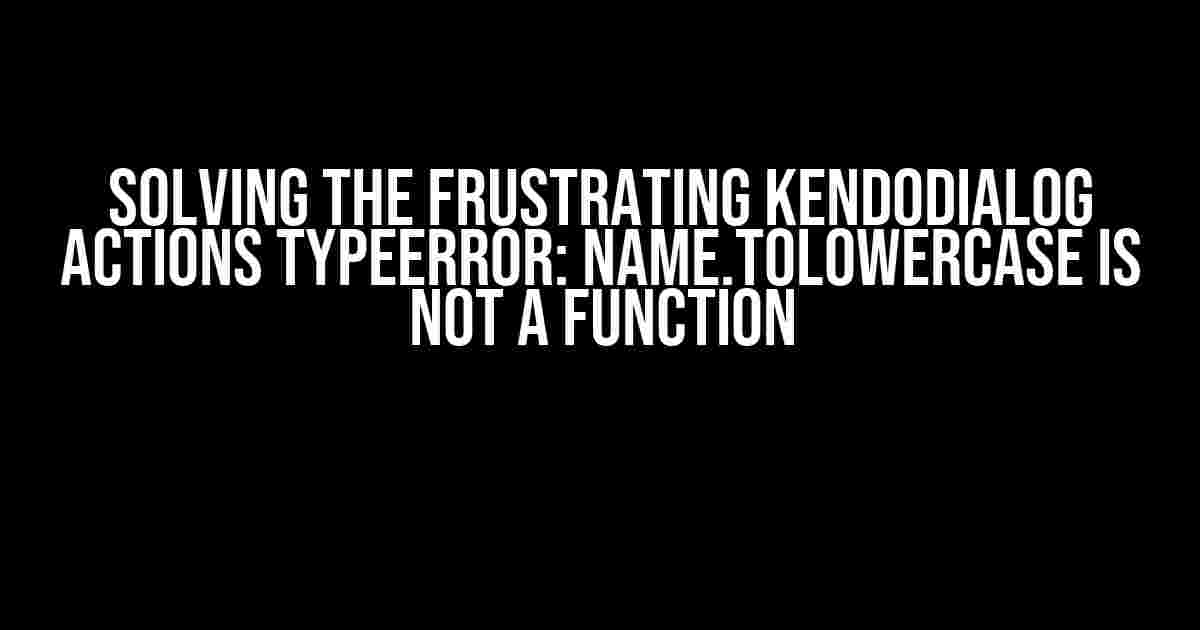Are you tired of encountering the annoying TypeError: name.toLowerCase is not a function error when working with KendoDialog actions? You’re not alone! Many developers have stumbled upon this frustrating issue, but fear not, dear reader, for we’re about to embark on a journey to eliminate this pesky error once and for all.
What’s Causing the Error?
To understand how to fix the issue, we need to comprehend what’s causing it in the first place. The TypeError: name.toLowerCase is not a function error typically occurs when you’re trying to perform an action on a KendoDialog, such as opening or closing it, but the action is not properly defined.
This can happen due to various reasons, including:
- Invalid action configuration
- Missing or incorrect action name
- Incorrect widget initialization
Step-by-Step Solution
Now that we’ve identified the possible causes, let’s take a step-by-step approach to resolving the issue:
Step 1: Verify Action Configuration
First, make sure your action configuration is correct. Check that you’ve defined the action correctly in your KendoDialog configuration:
$("#myDialog").kendoDialog({
actions: [
{
text: "Open",
action: function() {
// Your action code here
}
},
{
text: "Close",
action: function() {
// Your action code here
}
}
]
});
Pay attention to the `action` property; it should be a function that’s executed when the action is triggered.
Step 2: Ensure Correct Action Name
Next, verify that the action name is correct and matches the one defined in the configuration:
var dialog = $("#myDialog").data("kendoDialog");
dialog.open({ action: "Open" }); // Make sure the action name matches the one in the configuration
If you’re using a custom action name, ensure it’s spelled correctly and matches the case (lowercase or uppercase).
Step 3: Check Widget Initialization
Sometimes, the error can occur due to incorrect widget initialization. Make sure you’ve initialized the KendoDialog widget correctly:
$("#myDialog").kendoDialog({
// Configuration here
});
// Initialize the widget
$("#myDialog").data("kendoDialog");
Verify that the widget is initialized before attempting to perform an action.
Step 4: Debug and Inspect
If the above steps don’t resolve the issue, it’s time to debug and inspect the code:
console.log(dialog.actions); // Inspect the actions array
console.log(dialog.options.actions); // Inspect the actions configuration
Use the browser’s console to inspect the `actions` array and the `options.actions` configuration. This can help you identify any discrepancies or incorrect configurations.
Troubleshooting Common Scenarios
In addition to the above steps, let’s cover some common scenarios that might cause the TypeError: name.toLowerCase is not a function error:
Scenario 1: Dynamically Adding Actions
If you’re dynamically adding actions to the KendoDialog, ensure you’re using the correct syntax:
var dialog = $("#myDialog").data("kendoDialog");
dialog.setOptions({
actions: [
{
text: "New Action",
action: function() {
// Your action code here
}
}
]
});
Use the `setOptions` method to update the actions configuration.
Scenario 2: Using a Custom Action Name
If you’re using a custom action name, make sure it’s defined correctly in the configuration:
$("#myDialog").kendoDialog({
actions: [
{
text: "Custom Action",
action: "myCustomAction"
}
],
actionCallback: function(e) {
if (e.action === "myCustomAction") {
// Your custom action code here
}
}
});
Define the custom action name in the configuration and handle it in the `actionCallback` function.
Conclusion
With these steps and troubleshooting scenarios, you should be able to resolve the TypeError: name.toLowerCase is not a function error when working with KendoDialog actions. Remember to verify your action configuration, ensure correct action names, check widget initialization, and debug and inspect your code if needed.
By following this guide, you’ll be able to overcome this frustrating error and create seamless, interactive KendoDialog experiences for your users. Happy coding!
| Tip | Description |
|---|---|
| Use the KendoDialog API | Take advantage of the KendoDialog API to perform actions, such as opening or closing the dialog, instead of relying on custom implementations. |
| Check the KendoUI version | Ensure you’re using the latest version of KendoUI, as earlier versions might have bugs or limitations that can cause this error. |
| Consult the KendoUI documentation | Refer to the official KendoUI documentation for comprehensive information on KendoDialog actions and configuration. |
By following these tips and guidelines, you’ll be well on your way to resolving the TypeError: name.toLowerCase is not a function error and creating exceptional KendoDialog experiences.
Here are the 5 questions and answers about “KendoDialog actions TypeError: name.toLowerCase is not a function” in HTML format with a creative voice and tone:
Frequently Asked Question
KendoDialog got you down? Don’t worry, we’ve got the answers to the most common confusions!
What is the “TypeError: name.toLowerCase is not a function” error?
This error occurs when the KendoDialog tries to execute an action, but the “name” property is not a string. Make sure you’re passing a valid string as the action name!
Why does this error happen when I try to open a KendoDialog?
This error can happen when the KendoDialog is not properly initialized or when the action configuration is incorrect. Double-check your dialog initialization and action setup!
How do I fix this error when using a custom action in KendoDialog?
When using a custom action, ensure that the action name is a string and is properly defined in your action configuration. Also, verify that the custom action is correctly implemented and doesn’t return any undefined values!
Can I prevent this error from happening in the first place?
Yes! To prevent this error, always validate your action configuration and ensure that the action names are strings. You can also use the KendoDialog’s built-in validation features to catch any errors before they occur!
Where can I find more resources to help me with KendoDialog issues?
Check out the official Telerik Kendo UI documentation, as well as online forums and communities dedicated to Kendo UI development. You can also search for tutorials and blogs that provide in-depth guidance on using KendoDialog!
